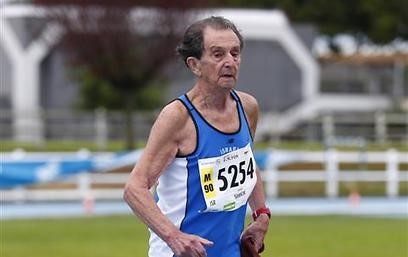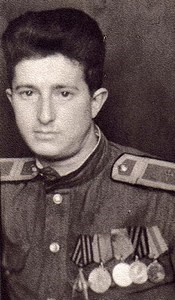Semion Simkin was born in 1923 (or 1924, according to other documents) in the shtetl of Liady in Belorussia, as Shimen Simkin. Upon graduating from a 7-class school in his native shtetl, Shimen went to Leningrad (now St. Petersburg, Russia), to study at a college (technicum) for road construction. In June 1941, while he was home on vacation, the Soviet-German war began. Shimen hurried back to Leningrad, and was then evacuated eastward with his college. Two months later, he was sent to an aircraft construction plant in the Moscow Region. Workers at such facilities were exempt from military service, but, in the spring of 1942, Semion Simkin learned that a sabotage group, which would be deployed behind enemy lines, was being formed in Moscow. He volunteered for this group and began his training in sabotage activities.
However, after a month and a half of training, Simkin was dismissed from the group. One of the officers remarked, after looking at him: "This one won't do; his appearance is too stereotypical; the Germans will recognize him as a Jew." Simkin was transferred to the NKVD military forces, but he disliked serving in the police forces – whose job was screening and punishing Soviet soldiers, rather than fighting the enemy – and asked to be transferred to the artillery. In September 1942, he began training at a camp for 45-mm (lightest) cannons near Moscow. In February 1943, Simkin was attached to the 685th Light Artillery Regiment as a communications man (responsible for the telephone connection). He began his combat service at the Western Front in western Russia (in the vicinity of Rzhev and Smolensk). In summer 1943, he was briefly transferred southward, to the Kursk Salient operation. There, Semion was wounded for the first time in July, and sustained a second injury in August 1943. In 1944, after being discharged from hospital, he took part in the liquidation of the Wehrmacht's Korsun Pocket in central Ukraine. He later fought in western Ukraine and Poland, moving into German Saxony and the Czech Republic in 1945.
While serving in Poland, Simkin narrowly avoided being sent to a penal battalion. The journalist Viacheslav (Tsalel) Tamarkin, who was also a native of Liady, wrote about this episode:
"Once, they stopped at a village well to take a drink of water. While drinking from a bucket, Shimon heard behind his back: 'You, Jewboy, hurry up!' He turned, saw a grinning, burly, infantryman, and hit him on the head with the butt of a carbine. The infantryman collapsed to the ground. Shimon touched him to make sure he was still breathing. His buddies stood by silently ..."
Translated from Russian from "My Shtetl" Website
However, the platoon commander took the side of the antisemitic infantryman. In the ensuing altercation, Semion called his commander a "white bone" (meaning a nobleman, an aristocrat). From that point on, there was no avoiding the penal battalion. Semion was rescued by the company commander, who transferred him to another platoon.
In the course of the war, Semion Simkin was awarded the Order of Glory, 3rd class, and a number of medals. His highest rank was sergeant.
After the war, Simkin initiated the commemoration of the Jews murdered by the Nazis in Liady. He took part in the exhumation and reburial of the bodies in 1966.
In 1998, Simkin settled in Israel. Despite his advanced age, he took part in Israeli marathons in the 2000s, only recently reducing his running distance to a "mere" ten kilometers. In 2015, Shimon Simkin won the gold medal at the world championship for 90-to-99-year-old runners held in Lyon, France.








